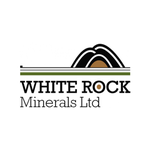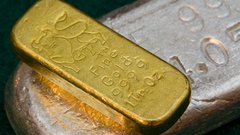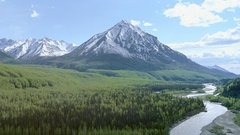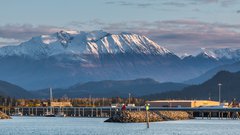High grade zinc mineralisation confirmed at White Rock Minerals Hunter Prospect
Hey! Looks like you have stumbled on the section of our website where we have archived articles from our old business model.
In 2019 the original founding team returned to run Next Investors, we changed our business model to only write about stocks we carefully research and are invested in for the long term.
The below articles were written under our previous business model. We have kept these articles online here for your reference.
Our new mission is to build a high performing ASX micro cap investment portfolio and share our research, analysis and investment strategy with our readers.
Click Here to View Latest Articles
White Rock Minerals Ltd (ASX:WRM) have today provided an upbeat update on its exploration activities currently underway at its 100% owned high-grade zinc VMS Red Mountain project in Alaska.
The first ever drill testing of the massive sulphide horizon discovered by recent ground reconnaissance at the project’s Hunter prospect has confirmed the zinc-rich massive sulphide discovery with massive sulphide intersected in the first two drill holes completed.
The Hunter prospect was recently discovered through geological ground reconnaissance, where a 60cm wide massive sulphide outcrop rich in sphalerite (zinc) and galena (lead) was found.
Subsequent prospecting mapped massive sulphide over 500m of strike within a carbonaceous phyllite that can be traced over one kilometre of strike. The zone of mineralisation is defined by anomalous soil geochemistry. Rock chip sampling of the massive sulphide from the discovery outcrop, as well as trenching along strike to define the position of the massive sulphide mineralisation, returned assay results up to 18.6% zinc, 5.4% lead, 2.3% copper, 147g/t silver and 0.7g/t gold.
The massive sulphide horizon occurs along a steep south facing slope, strikes east-west and dips at approximately 45° towards the north. The massive sulphide horizon is hosted towards the base of a sequence of carbonaceous phyllites at the contact with underlying maroon-green phyllites. The horizon is locally associated with the development of chert beds within the sequence. A number of faults are interpreted to offset the horizon locally.
Holes HR18-01 & HR18-02 tested the massive sulphide 50m down dip from the discovery outcrop on the surface and then a second follow-up hole another 30m down dip from that hole and on the same cross section.
The first drill hole (HR18-01) was located above the massive sulphide horizon up slope to the north and drilled vertically so as to intersect the massive sulphide at a shallow position and confirm the dip of the VMS horizon. It intersected 1.4m at 17.4% zinc, 3.9% lead, 1.6% copper, 90g/t silver and 0.2g/t gold from 48.25m down hole, for 25.8% zinc equivalent (ZnEq).
The second drill hole (HR18-02) targeted the massive sulphide horizon down-dip to the north from the same location. Both drill holes intersected massive sulphide mineralisation with high grade zinc, similar to the discovery outcrop. It intersected 1.8m at 13.8% zinc, 3.1% lead, 0.9% copper, 56g/t silver and 0.2g/t gold from 60.84m down hole, for 19.5% ZnEq.
Of course, as with all minerals exploration, success is not guaranteed — consider your own personal circumstances before investing, and seek professional financial advice.
Subsequently, a third hole (HR18-04) was drilled a further 80m down-dip and 5cm of massive sulphide within a 30cm interval of laminated pyrite was intersected. While HR18-04 didn’t intersect significant massive sulphide, the mineralisation at Hunter appears analogous to that at West Tundra, located nine kilometres to the east-northeast.
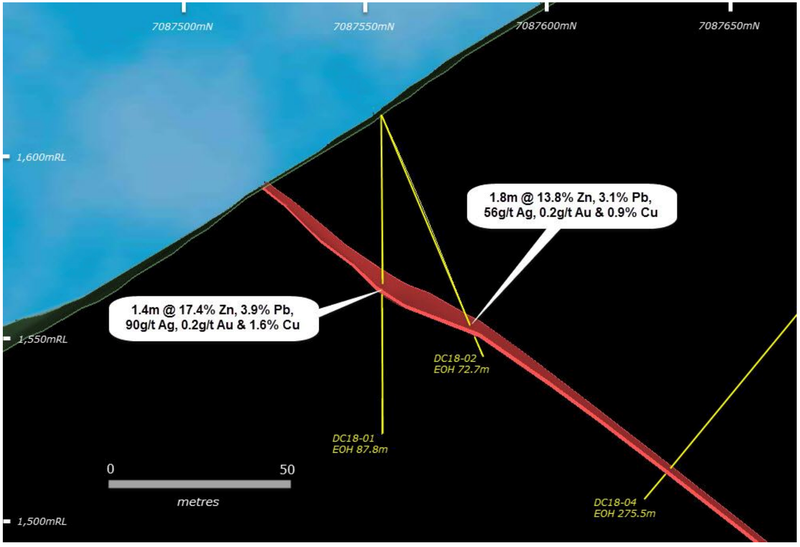
The Hunter prospect remains open down dip, and the VMS horizon that hosts this prospect has been traced for over 500 metres on the surface. The drill rig has now moved to test another new target at the South Platypus prospect, three kilometres east of the Hunter prospect.
At West Tundra the mineralised horizon is laterally extensive along strike and down-dip with some drill holes occasionally returning only narrow intersections where the mineralised body pinches locally. No drilling has yet tested the Hunter mineralised horizon along strike to the east or west or further down-dip.
The image below shows the location of new prospects identified from surface reconnaissance and surface geochemical sampling highlighting anomalous zinc and lead soil geochemistry (red squares >1,000ppm zinc or lead and orange squares >500ppm zinc or lead), including the surface projection of massive sulphide mineralisation at Dry Creek and West Tundra, and all drill hole collars (green – 2018; black dots historic), on topography.
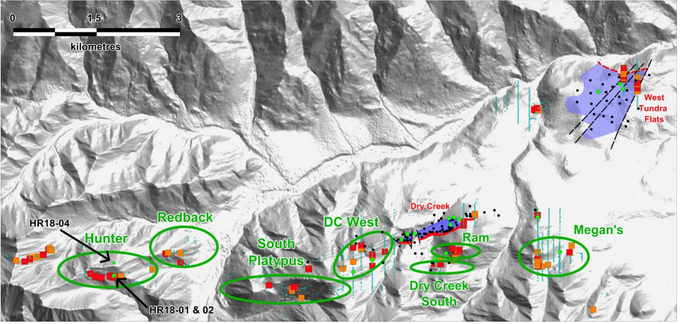
MD and CEO Matt Gill said, “There aren’t many places in this world where you find outcropping zinc-rich massive sulphide (with lead, copper, silver and gold) and then promptly drill test that and get a positive response. We are excited by the success of our first field season in Alaska at the Red Mountain project. Through an aggressive approach deploying a drill rig early on the tail of geological prospecting, surface sampling and ground geophysics, we have been rewarded with the discovery of massive sulphide mineralisation in outcrop within three months of starting our very first program. Mapping and drilling has now illustrated that the Hunter prospect has scale for more detailed drill evaluations in the coming year.
“The high-grade zinc results from the first two drill holes have confirmed mineralisation sampled from the discovery outcrop. While the third hole intersected a narrower band of massive sulphide, we know from the West Tundra deposit (9km to the west) that occasionally the VMS horizon pinches locally, but the potential remains high for good thickness and grade along strike and further down dip. Significantly, Hunter also contains around 1% copper.
“The discovery of a new massive sulphide occurrence at Hunter goes a long way to supporting the thesis that the Red Mountain project has the potential to host multiple deposits and expand into a true VMS camp. The Hunter discovery shows that our tenement package could be hiding several other massive sulphide deposits ripe for discovery through systematic ground coverage and the application of modern geochemistry and geophysics techniques which we have been using this field season.”
General Information Only
S3 Consortium Pty Ltd (S3, ‘we’, ‘us’, ‘our’) (CAR No. 433913) is a corporate authorised representative of LeMessurier Securities Pty Ltd (AFSL No. 296877). The information contained in this article is general information and is for informational purposes only. Any advice is general advice only. Any advice contained in this article does not constitute personal advice and S3 has not taken into consideration your personal objectives, financial situation or needs. Please seek your own independent professional advice before making any financial investment decision. Those persons acting upon information contained in this article do so entirely at their own risk.
Conflicts of Interest Notice
S3 and its associated entities may hold investments in companies featured in its articles, including through being paid in the securities of the companies we provide commentary on. We disclose the securities held in relation to a particular company that we provide commentary on. Refer to our Disclosure Policy for information on our self-imposed trading blackouts, hold conditions and de-risking (sell conditions) which seek to mitigate against any potential conflicts of interest.
Publication Notice and Disclaimer
The information contained in this article is current as at the publication date. At the time of publishing, the information contained in this article is based on sources which are available in the public domain that we consider to be reliable, and our own analysis of those sources. The views of the author may not reflect the views of the AFSL holder. Any decision by you to purchase securities in the companies featured in this article should be done so after you have sought your own independent professional advice regarding this information and made your own inquiries as to the validity of any information in this article.
Any forward-looking statements contained in this article are not guarantees or predictions of future performance, and involve known and unknown risks, uncertainties and other factors, many of which are beyond our control, and which may cause actual results or performance of companies featured to differ materially from those expressed in the statements contained in this article. S3 cannot and does not give any assurance that the results or performance expressed or implied by any forward-looking statements contained in this article will actually occur and readers are cautioned not to put undue reliance on forward-looking statements.
This article may include references to our past investing performance. Past performance is not a reliable indicator of our future investing performance.

